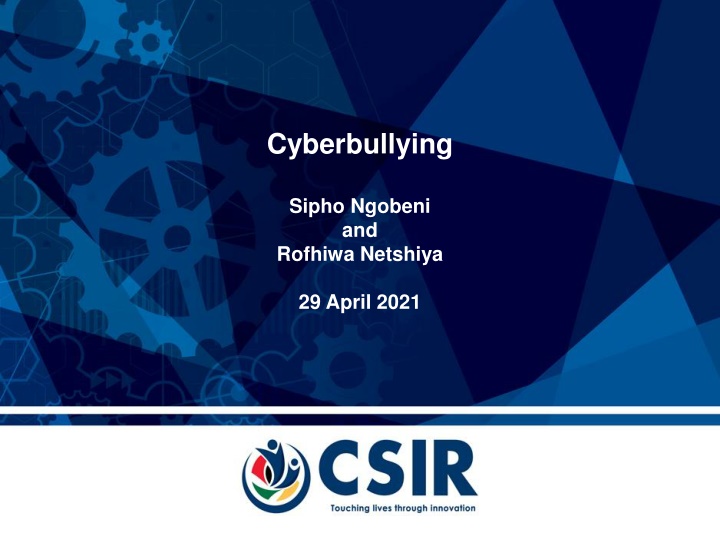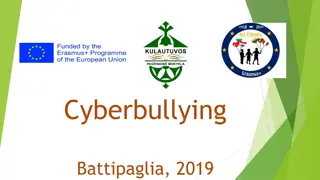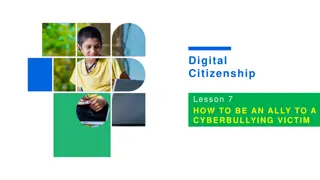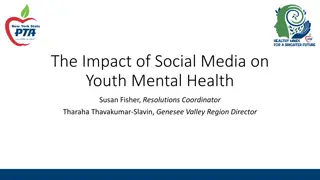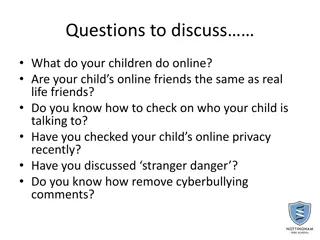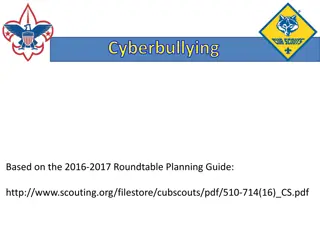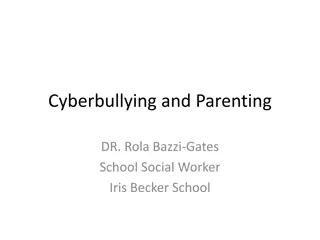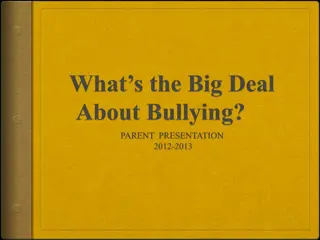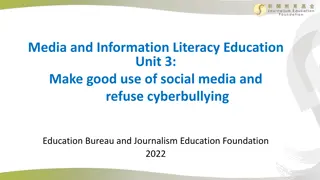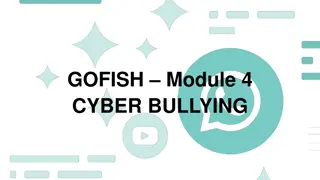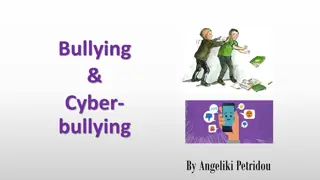Cyberbullying: Causes, Effects, and Prevention
Cyberbullying is the act of harassing, threatening, or humiliating others online. Learn about its negative impacts, prevalence, and legal implications. Discover how to protect yourself from cyberbullying incidents.
Download Presentation

Please find below an Image/Link to download the presentation.
The content on the website is provided AS IS for your information and personal use only. It may not be sold, licensed, or shared on other websites without obtaining consent from the author.If you encounter any issues during the download, it is possible that the publisher has removed the file from their server.
You are allowed to download the files provided on this website for personal or commercial use, subject to the condition that they are used lawfully. All files are the property of their respective owners.
The content on the website is provided AS IS for your information and personal use only. It may not be sold, licensed, or shared on other websites without obtaining consent from the author.
E N D
Presentation Transcript
Cyberbullying Sipho Ngobeni and Rofhiwa Netshiya 29 April 2021
Contents Introduction What is Cyberbullying? Why people get Cyberbullied Negative effects of Cyberbullying Cyberbullying incidents in South Africa Why is it difficult to stop Cyberbullying? Some statistics on Cyberbullying How to protect yourself Legal implications 2
Introduction Computer Malware Social Aspects of Cybersecurity Mobile Security Cyberbullying Social Engineering Cybersecurity Awareness Programme Physical Security Safe Surfing 3
What is Cyberbullying Harassment done through the use of technology (Bigelow, et al 2016). When someone repeatedly makes fun on another person online (R. Donegan, 2012). Repeatedly and intentionally harasses, mistreats, or makes fun of another person online (J.W. Patchin, & S. Hinduja, 2021). Deliberate use of online digital media to communicate false, embarrassing or hostile information about another person (Silva, et al 2016). Intimidate another person on communication networks (Wan Ali, et al 2018). 4
What is Cyberbullying (continued) When someone uses electronic communication to intentionally: Harass; Threaten; Embarrass; Intimidate; Stalk; Humiliate; and Make fun of someone. 5
What is Cyberbullying (continued) Cyberbullies use: Emails; Instant messaging; Text messages sent via cellphones; Digital photos; and Any other electronic communications. 6
What is Cyberbullying (continued) The Cyberbully can: Post gossip or rumours; Send out messages pretending to be you; and Post secrets and pictures for everyone to see. 7
Why people get Cyberbullied Source: https://www.broadbandsearch.net/blog/cyber-bullying-statistics 8
Why people get Cyberbullied (continued) Sometimes cyberbullies pick random people because of something they did online that the bully did not like, e.g. Made a comment; Sent a mail; or Joined a group. Most victims are children, but there are adults also. More prevalent on adolescent age. 9
Negative effects of Cyberbullying Depression, sadness, anger, frustration, anxiety, or fear especially if your child is more emotional after using the Internet or a mobile phone. Low self-esteem, family problems. Avoiding friends, activities, or school. Academic difficulties e.g. poor grades. Expressing subtle comments that indicate you are disturbed or upset. Delinquency, school violence and suicidal thoughts. 10
Cyberbullying Incidents in South Africa Warder and inmate sex tape, March 2021. Celebrity cyberbullying experience, April 2021. School cyberbullying: KwaZulu-Natal school pupil cyberbullied, September 2020. Limpopo cyberbullying incident resulting in suicide, April 2021. Eastern Cape high school pupil bullied through schoolmate creating a fake profile of her, July 2020. Gauteng 13-year old pupil committed suicide after her naked photograph was distributed at her school via WhatsApp, 2018. 11
Why is it difficult to stop Cyberbullying? People still don t see the harm associated with it. There are more serious problems to worry about. Parents don t have the knowledge or time to keep up with their children s online behaviour. Parents claim schools should be covering it during class. Educators don t know when and how to intervene in online behaviours that occur away from school, but still involve their students. Law enforcement hesitant to get involved unless there is clear evidence. Youth should feel comfortable talking to adults. Get everyone involved youth, parents, educators, counsellors, youth leaders, law enforcement, social media companies, and community. 12
Some statistics on Cyberbullying Source: https://www.broadbandsearch.net/blog/cyber-bullying-statistics 13
Some statistics on Cyberbullying (Continued) Source: https://www.broadbandsearch.net/blog/cyber-bullying-statistics 14
Some statistics on Cyberbullying (Continued) Source:M. Newall, Cyberbullying, A Global Advisory Survey, 2018 15
Some statistics on Cyberbullying (Continued) Source: M. Newall, Cyberbullying, A Global Advisory Survey, 2018 16
How to protect yourself Report to an adult (parent, teacher or someone you trust). Ignore minor teasing or name calling, do not respond. Use account privacy settings. Keep evidence of cyberbullying and show to an adult. Tell your parents about the sites you visit online. Never give out personal information online. Watch out to whom you talk to. Pause before you post something online. 17
Protect yourself The role of parents Ensure the child feels safe, convey unconditional support. Work with your child to arrive to a mutually agreed cause of action. Discuss the Cyberbullying matter with a school. Contact parents of the aggressor or ISP/content provider to investigate the matter and remove offending material. Report the issue to police in case of physical threats or extortion, stalking, blackmail, and sexual exploitation of minors. Educate your child about appropriate online behaviours. Reinforce positive morals and values. 18
Protect yourself The role of schools Educate communities about the responsible use of their devices. Educate children that all forms of Cyberbullying are wrong and can be subjected to discipline. Regularly discuss issues related to appropriate online communication. Remind students of the rules of acceptable use through signage around the school premises. Establish harassment and bullying policies. Develop creative responses for harassment resulting in insignificant harm. Inform the parents where necessary. Detention, suspension, change of placement, or even expulsion maybe necessary in extreme cases. 19
Protect your children 1. If you have a computer at home, it should preferably be in a common room and not in the children s rooms. Children are less likely to go onto suspicious sites if they know that their parents can look over their shoulder; and If something does happen, parents are close by to advice on what to do next. 2. Talk to your children about personal security. Just as you would remind your children regularly to lock the door when they leave the house, you need to remind them to lock the Internet door. 20
Protect your children 3. their passwords. Remind your children that they should never give out If anybody gets your password, they can find out your personal data; and Some people will use this information and steal your identity. 4. Remind your children that they should never give out their address or telephone numbers. 5. Install Internet monitoring software on your children s computer. Low-cost products; Invisibly monitor the activities of your kids, and privately email yourself the results as often as you like; and Can track Internet sites visited, downloads, chat room conversations, and instant messaging. 21
Legal implications Perpetrators of Cyberbullying can be charged on: Crimen Injuria dignity of the victim is injured. Sexual exploitation and grooming threating someone to obtain something from him/her. Criminal defamation E.g. posting of lies about someone on social media. 22
Cyberbullying detection - EduCyber We are currently developing a technology platform that: Detects Cyberbullying in a chartroom. Automatically detects Cyberbullying on the chat group and blocks out those users who continue to send hate speeches to the group. Gives three warning messages to the user and if they persist, they will be blocked out of the chat group. 23
References J. Bigelow, A Edwards, and L. Edwards, Detecting Cyberbullying using Latent Semantic Indexing, Proceedings of the First International Workshop on Computational Methods for CyberSafety, 2016 , pg 11 14 R. Donegan, Bullying and Cyberbullying: History, Statistics, Law, Prevention and Analysis, 2012, The Elon Journal of Undergraduate Research in Communications , Vol. 3, No. 1. pg. 33 42. J.W. Patchin, and S. Hinduja, Cyberbullying fact sheet: Identification, Prevention, and Response, Cyberbullying Research Center, 2021. Y.N Silva, C. Rich, and D Hall, BullyBlocker: Towards the Identification of Cyberbullying in Social Networking Sites, 2016 IEEE/ACM International Conference on Advances in Social Networks Analysis and Mining (ASONAM), 2016, pp. 1377-1379. 2016. M. Newall, Cyberbullying, A Global Advisory Survey, 2018. (Available at: https://www.ipsos.com/sites/default/files/ct/news/documents/2018-06/cyberbullying_june2018.pdf) All the latest cyberbullying statistics and what they mean in 2021 (Available at: https://www.broadbandsearch.net/blog/cyber-bullying-statistics) Action against cyberbullying (Available at: https://www.legalwise.co.za/help-yourself/legal-articles/cyber-bullying) The many forms of cyberbullying: Bongekile s story (Available at: https://www.thesouthafrican.com/lifestyle/health- fitness/many-forms-of-cyberbullying/ ) 24
